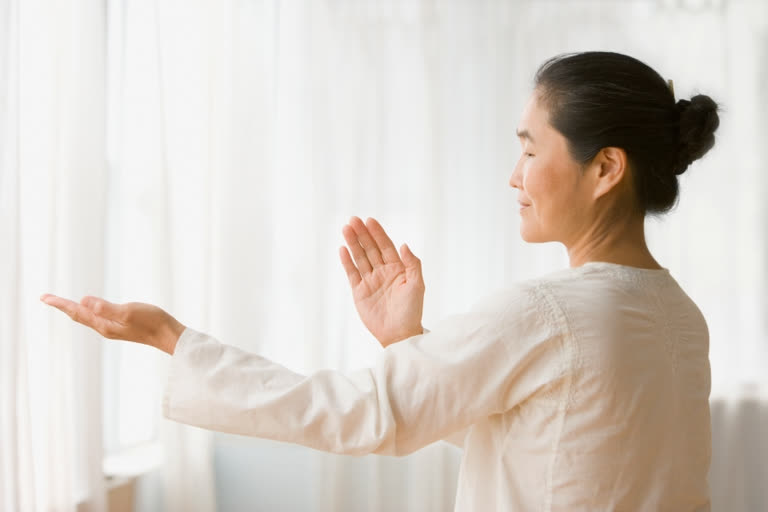Stroke survivors who practiced a seated form of Tai Chi had equal or greater improvement in hand and arm strength, shoulder range of motion, balance control, symptoms of depression and activities of daily living after three months, compared to those who participated in a standard stroke rehabilitation exercise program, according to new research published today in Stroke, the peer-reviewed flagship journal of the American Stroke Association, a division of the American Heart Association.
The American Heart Association’s/American Stroke Association’s Guidelines for the Early Management of Patients with Acute Ischemic Stroke recommend people start stroke rehabilitation within seven days and continue for up to six months after a stroke. However, many survivors opt out of rehabilitation therapy because they lack physical stability or are unable to fully use their arms. The Association also notes in a Scientific Statement about Physical Activity and Exercise Recommendations for Stroke Survivors that flexibility and muscle strength training, including yoga and Tai Chi, are reported to be beneficial for stroke survivors in improving balance, quality of life and mental health, while reducing the fear of falling.
Tai Chi, a traditional Chinese martial art, consists of a series of slow, careful movements of the hands, arms, neck, legs and core combined with deep breathing. The novelty of this study is that researchers developed a sitting routine of Tai Chi exercises for people who had a recent ischemic stroke (blocked blood vessel to the brain) and experienced hand and arm weakness or partial paralysis.
“Tai Chi has a long history as a form of exercise in China. We revised the Tai Chi movements for people who have weakness or partial limb paralysis. It is tailored so that participants can move one arm with the help of the healthy arm,” said Jie Zhao, Ph.D., lead study author and a lecturer at Yunnan University of Traditional Chinese Medicine in Yunnan, China.
The study was conducted at two traditional Chinese medicine hospitals in Kunming, China. Researchers recruited 160 adults (average age of 63 years; 81 men and 79 women) who had suffered their first-ever ischemic stroke within six months of joining the study and retained their use of at least one arm. Among the study participants, half were randomly assigned to the sitting Tai Chi program, and the other half were part of the control group that practiced a standard stroke rehabilitation exercise program (hospital-recommended upper limb movements; the amount, implementation strategies and caregiver responsibilities were similar to the Tai Chi group).
Also Read: Mini Stroke: Difference, Risk Factors And Preventive Tips
The participants in the sitting Tai Chi group received individual training from a Tai Chi instructor for one week during hospitalization and a self-guided video to practice at home for three days a week for 11 weeks. The control group received a self-guided exercise video of standard exercises to practice at home for 12 weeks. Family members and caregivers supervised the at-home exercise for both study groups. Sixty-nine people in the sitting Tai Chi group and 65 people in the control group completed the 12-week program and 4-week follow-up. Physical function and psychological state were measured for all study participants via questionnaires and assessment tools at the start of the study and at four additional times during the 16-week program, and the outcomes of the two groups were compared.
Researchers analyzed the questionnaires and assessment tools and found:
- Those in the sitting Tai Chi group had better hand and arm function and sitting balance control compared to those in the standard stroke rehabilitation group.
- The participants in the sitting Tai Chi group had significant reductions in symptoms of depression, better shoulder range of motion and showed significant improvements in activities of daily living and quality of life compared with the control group.
- More than half the people in the Tai Chi group continued to practice after the 12-week intervention. Improvement in these measures continued during the 4-week follow-up period for the Tai Chi group.
“Sitting Tai Chi can be practiced in a chair or wheelchair and is very convenient since it can be done in your home. The program costs almost nothing to practice, and it doesn’t require any special equipment or travel time,” Zhao said.
This is the first randomized controlled trial focused on a modified sitting Tai Chi routine and found improved short-term outcomes in a group who may struggle to adhere to a standard stroke rehabilitation exercise program. The results demonstrate this mind-body practice is an effective option to enhance balance, coordination, strength and flexibility, particularly for stroke survivors with hand and arm weakness or partial paralysis. “My follow-up study will measure the long-term effects of sitting Tai Chi,” Zhao said. “People will most likely need to adhere to the sitting Tai Chi exercise beyond 12 weeks to get the beneficial long-term effects.”
Also Read: Five childhood risk factors predict heart attacks and strokes in adulthood



